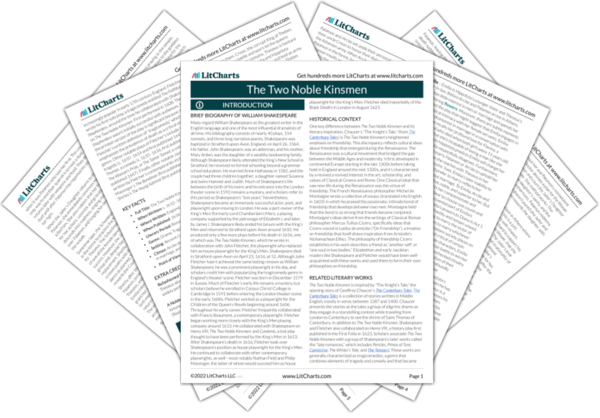Love and Irrationality
The Two Noble Kinsmen’s central conflict revolves around the love triangle that develops between the knights Arcite and Palamon and the Athenian duke’s sister-in-law, Emilia. Arcite and Palamon are cousins who have been imprisoned in Athens, and they become enamored with Emilia after witnessing her wandering around the garden below their cell. Almost immediately, their love morphs into a maddening obsession that threatens to destroy the integrity of their close friendship to which…
read analysis of Love and IrrationalityFate, Fortune, and Divine Providence
While characters in The Two Noble Kinsmen have some degree of agency over their actions, they generally accept that fortune and fate shape their lives to a far greater extent than free will and determination. However, this doesn't mean they regard life as meaningless and arbitrary. To the contrary, characters generally accept whatever fate or fortune befalls them as a sign of Providence, or divine guidance. In other words, it’s the gods’ whims—not mere chance—that…
read analysis of Fate, Fortune, and Divine ProvidenceChivalry, Honor, and Pride
William Shakespeare and John Fletcher based The Two Noble Kinsmen on Geoffrey Chaucer’s well-known work of medieval literature, The Canterbury Tales, a satirical collection of stories written mostly in verse. The particular story that The Two Noble Kinsmen draws from, “The Knight’s Tale,” explores themes that relate to the chivalric code, a set of rules that governed the behavior of medieval knights and gentlemen. Though The Two Noble Kinsmen is set in Ancient Greece…
read analysis of Chivalry, Honor, and Pride
Friendship
One of The Two Noble Kinsmen’s most significant departures from Chaucer’s “The Knight’s Tale” is its heightened emphasis on friendship. The play establishes three primary pairs of close friends in its opening scenes: Theseus and Pirithous, Emilia and Flavina, and Arcite and Palamon, each of which depicts an intimate bond. These friendships are largely defined by shared respect or affection, and this creates a certain equality in the relationships. Arcite and…
read analysis of FriendshipGender and Power
The female characters in The Two Noble Kinsmen don’t enjoy the same freedoms and intellectual treatment as the male characters, largely because of the sexist cultural climate in which the play was written. Although women hold some power or agency, they often lack the means to exercise this power directly and must convey their thoughts and wishes through male characters. For example, Emilia convinces Theseus to spare Palamon and Arcite their lives in Act 3…
read analysis of Gender and Power








